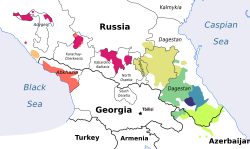Tindi is a Northeast Caucasian language spoken in the Russian republic of Dagestan. Tindis have no individual designation for their language, but those living in the village of Idar call their language Idarab mitstsi meaning 'the language of the Idar village'. It is only an oral language; Avar or Russian are used in written communication instead.[2] Tindi vocabulary contains many loanwords from Avar, Turkish, Arabic, and Russian.[3] It has approximately 4,500 speakers.[1]
Phonology
Vowels
There are 20 phonemic vowels in Tindi.[4][5]
| Front | Central | Back | |
|---|---|---|---|
| Close | i iː | u uː | |
| Mid | e eː | o oː | |
| Open | a aː |
Nasalized vowels may also exist as /ĩ, ẽ, ã, õ, ũ/ and as long-nasalized /ĩː, ẽː, ãː, õː, ũː/.
Consonants
| Labial | Dental | Alveolar | Palatal | Velar | Uvular | Pharyn- geal |
Glottal | ||||||||||
|---|---|---|---|---|---|---|---|---|---|---|---|---|---|---|---|---|---|
| central | lateral | central | palatalized | ||||||||||||||
| lenis | fortis | lenis | fortis | lenis | fortis | lenis | fortis | lenis | fortis | lenis | fortis | ||||||
| Nasal | m | n | |||||||||||||||
| Plosive | voiceless | p | t | k | kː | kʲ | kʲː | ||||||||||
| ejective | tʼ | kʼ | kʲʼ | ʔ | |||||||||||||
| voiced | b | d | ɡ | ɡʲ | |||||||||||||
| Affricate | voiceless | t͡s | t͡sː | t͡ʃ | t͡ʃː | t͡ɬː | q͡χː | ||||||||||
| ejective | t͡sʼ | t͡sʼː | t͡ʃʼ | t͡ʃʼː | t͡ɬʼː | q͡χʼː | |||||||||||
| Fricative | voiceless | s | sː | ʃ | ʃː | ɬ | ɬː | ç | χ | χː | ħ | h | |||||
| voiced | z | ʒ | ʁ | ʕ | |||||||||||||
| Trill | r | ||||||||||||||||
| Approximant | w | l | j | ||||||||||||||
References
- ^ a b Том 5. «Национальный состав и владение языками». Таблица 7. Население наиболее многочисленных национальностей по родному языку
- ^ Tindi language at Ethnologue (18th ed., 2015) (subscription required)
- ^ Akiner, Shirin (1986). Islamic Peoples Of The Soviet Union. Routledge. p. 264. ISBN 978-1-136-14266-6.
- ^ "Грамматика тиндинского языка | Малые языки России". minlang.iling-ran.ru. Retrieved 2024-09-27.
- ^ "Тиндинский язык | Малые языки России". minlang.iling-ran.ru. Retrieved 2024-09-27.
- Magomedbekova, Z. M. (2001). "Tindinskij Jazyk". Yazyki mira: Kavkazskie Yazyki. Moskva: Academia. pp. 283–291.
External links











You must be logged in to post a comment.